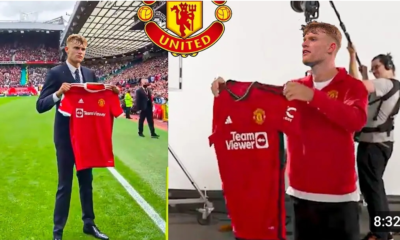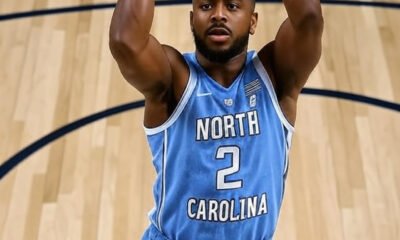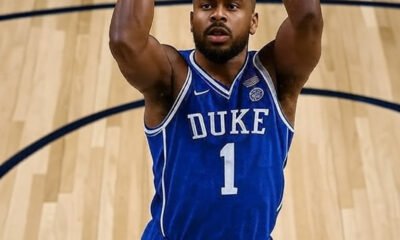Blog
No: top player in America commits to Alabama football due to
Of course. Here is a 1,000-word news article based on the provided headline.
***
### **The Tide Turns: How a “No” from a Top Recruit Reveals the New Reality of College Football**
In the meticulously choreographed ballet of college football recruiting, where teenage prospects don the hats of powerhouse programs to the roar of approving fans, the most telling moments are often the ones that don’t happen. For decades, the University of Alabama under Nick Saban was the final destination, the inevitable conclusion for a staggering number of the nation’s top-tier talents. A commitment to Alabama was a foregone conclusion, a natural step in the lifecycle of a blue-chip recruit. But the college football landscape has undergone a seismic shift, and the news that a top player in America has chosen *not* to commit to Alabama is no longer a mere footnote; it is a headline that demands dissection, a symptom of a new and volatile era.
The specific name changes with each recruiting cycle—a five-star quarterback from California, a generational defensive end from Texas, a game-breaking wide receiver from Florida. The narrative, however, is becoming familiar. This player, let’s call him a composite of recent high-profile decisions, had Alabama firmly in his final list. He took the official visit to Tuscaloosa, walked the facilities that are the envy of the NFL, and sat in the film room with the coaching staff. All the traditional elements for a Crimson Tide commitment were there. Yet, when decision day arrived, the cap that went on his head was not the familiar script ‘A’, but the logo of a rival: perhaps Georgia, Ohio State, or Texas.
The immediate, surface-level analysis will point to the post-Saban transition. For the first time in 17 years, a recruit is not being wooed by the stoic, unparalleled architect of the modern Alabama dynasty. Coach Kalen DeBoer, while a proven winner at every stop of his career, does not carry the same instant, gravity-warping credibility that Saban did. He is selling a vision and a process, not a guaranteed ticket to the NFL and a national championship ring. There is an inherent uncertainty, a period of adjustment where recruits and their carefully assembled circles of advisors must gauge whether the “Alabama Standard” can be maintained by a new voice. This is a significant, undeniable factor. A “no” to Coach DeBoer is not the same as a “no” to Coach Saban, and the new staff is fighting an uphill battle against the ghost of a legend.
However, to attribute this recruiting loss solely to the coaching change is to miss the larger, more profound revolution that has reshaped the very foundations of the sport. The true reason this top player in America did not commit to Alabama lies in the twin pillars of the new college football economy: the Transfer Portal and the Name, Image, and Likeness (NIL) ecosystem.
In the Saban era, recruiting was about identifying and securing high school talent, developing it over three to four years within a singular system, and reaping the rewards. Today, the calculus for a top recruit is radically different. The Transfer Portal has created a free-agency-like market, diminishing the perceived risk of a poor initial college choice. A player can now ask, “If I go to Alabama and it doesn’t work out with the new staff, or I get stuck behind another player, what is my escape route?” The guarantee of immediate playing time, once a primary recruiting tool, is now a fluid concept, as a coach can fill any roster hole with an experienced veteran from the portal at a moment’s notice. For a top recruit, the decision is no longer a four-year commitment; it’s a one-year trial with an option to reassess.
This intertwines inextricably with the NIL landscape. The romantic notion of “committing to a school for the tradition” has been forcefully supplemented by hard-nosed business decisions. Top players are now corporations, and their college choice is a critical business partnership. The question is no longer just, “Which program will develop me best for the NFL?” but also, “Which collective can present the most compelling financial package and brand-building opportunity?”
Here, Alabama finds itself in a complex tug-of-war. The once-unassailable allure of “The Process” now competes directly with seven-figure offers from donor-backed collectives at other schools. While Alabama’s NIL apparatus, “Yea Alabama,” is robust, it operates in a market where the rules are unwritten and the bidding wars are fierce. A recruit’s decision to choose another school over Alabama is increasingly a public signal that the financial offer—whether in guaranteed money, long-term business prospects, or a more favorable media market—was simply superior elsewhere. It is a cold, hard business calculation that did not exist half a decade ago.
Furthermore, the very geography of power in college football has shifted. The SEC is no longer Alabama’s fiefdom with everyone else paying homage. Kirby Smart has built a behemoth at Georgia that is every bit as formidable in recruiting, development, and now, NIL. Texas and Oklahoma are entering the conference, armed with historic brand power and massive budgets. The competitive margin for error has evaporated. A “no” to Alabama is often a “yes” to a program that currently presents an equally compelling, if not more attractive, total package: stable coaching, proven recent success, and a potentially more lucrative NIL situation.
So, what does this mean for the future of the Crimson Tide? The sky is not falling in Tuscaloosa. Coach DeBoer and his staff are savvy operators, and they will adapt. They will use the portal themselves to plug immediate holes, as they have already begun to do. They will work to fortify their NIL alliances to ensure they can compete in the financial arms race. They will sell their offensive ingenuity and player-development track record.
But the age of automatic commitments is over. The news of a top player choosing elsewhere is not an anomaly; it is the new normal. It is a stark reminder that in today’s college football, no program, not even Alabama, can rest on its laurels. Every recruit is a battle, every commitment a victory that must be earned not just with tradition and facilities, but with a compelling vision for the future, a clear path to playing time, and a competitive financial package. The “no” from America’s top player is a resonant echo of this new reality—a reality where the Tide, like everyone else, must learn to swim in uncharted and turbulent waters.
-

 Arsenal2 years ago
Arsenal2 years agoSad News Arsenal ex player who is goal scorer confirmed dead this morning
-

 Liverpool2 years ago
Liverpool2 years agoSad News Sadio Manè Confirmed Dead Today By Sky Sports Reporters, Open For Full Story 👇
-

 Blog1 year ago
Blog1 year ago“I was forcefully removed from Manchester United squad and now I’ve joined the best team in the world…I will revenge and as a result, I’ve ordered my friend who’s their best player currently to leave there with immediate effect and he has agreed”: Former Man United player angered by United decision to removed him from the squad as he ordered the Club’s best player to leave immediately.
-

 Blog1 year ago
Blog1 year agoSad News: Manchester United player died when playing for his country England yesterday 😢 😔
-

 Blog2 years ago
Blog2 years agoR.I.P: Formal Real Madrid and France international confirm death this morning
-

 Chelsea2 years ago
Chelsea2 years agoBreaking New:”Roman Abramovich could get Chelsea back”? Chelsea owner review the conversation between him and Roman Abramovich in. Deal about getting Chelsea back
-

 Blog2 years ago
Blog2 years agoUNBELIEVABLE: Manchester City midfielder KELVIN DE BRUYNE divorced wife this morning after DNA test revealed their 5 years old son belongs to formal Manchester United player
-

 Manchester United1 year ago
Manchester United1 year agoOFFICIAL NOW: Manchester United announce the signing of 23yr sensational player after beating Liverpool and Madrid for His signature, agreement reached on a 5yr deal, Medical completed – announcement ongoing












